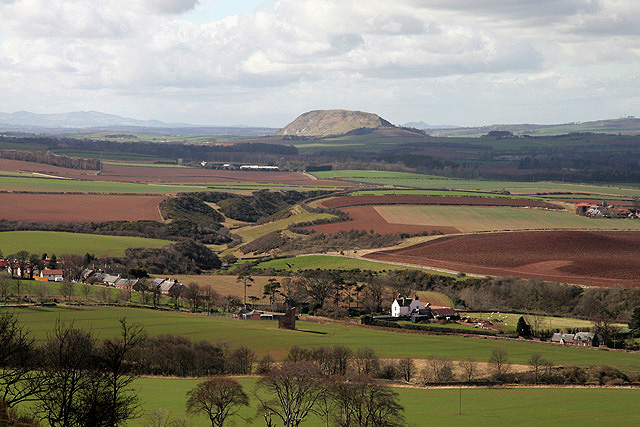The history of Doon Hill is steeped in legend and folklore. According to local legend, the hill is home to a fairy queen who grants wishes to those who climb to the top and leave an offering. This has led to a tradition of leaving small gifts and trinkets at the summit, which can be seen hanging from the branches of the trees. Despite its mystical reputation, Doon Hill has a rich history that dates back thousands of years, with evidence of human settlement found in the surrounding area.
Historical Background
Neolithic Period
Doon Hill is a prehistoric site located in East Lothian, Scotland. The hill is believed to have been occupied during the Neolithic period, which lasted from around 4000 BC to 2500 BC. During this time, the people who lived in the area were primarily farmers and herders who built stone structures and monuments, including standing stones and burial cairns.
On Doon Hill, there are several prehistoric features, including a stone circle and a cairn. The stone circle is believed to have been used for rituals or ceremonies, while the cairn was likely used as a burial site.
AD 500s
The Picts were known for their distinctive art and unique language, which was not related to any other known language. They also built impressive fortifications, including the famous Pictish symbol stones.
Doon Hill was likely an important site for the Picts, as it was located near the coast and would have been a strategic location for trade and defence. Today, the hill is a popular tourist destination and is protected as a scheduled monument.
Archaeological Discoveries
Brian Hope-Taylor’s Excavations
Doon Hill, located in East Lothian, has been a site of archaeological interest for many years. The most significant excavations were carried out by Brian Hope-Taylor in the 1950s and 1960s. Hope-Taylor’s work uncovered a wealth of archaeological remains, including evidence of timber halls and a palisade.
Timber Halls
Radiocarbon dating of the timber used in the construction of the halls suggests that they were built in the early medieval period, around the 7th or 8th century AD. The halls were likely used for several centuries before being abandoned.
Palisade
In addition to the timber halls, Hope-Taylor’s excavations also uncovered evidence of a timber palisade. The palisade was likely built as a defensive structure, to protect the inhabitants of the settlement from external threats.
The palisade was constructed using a series of closely spaced vertical posts, with horizontal beams connecting them. The palisade would have been an imposing sight, standing several metres high and encircling the settlement.
Historic Environment Scotland
Doon Hill is a site of significant historical importance in East Lothian, Scotland. The site is managed by Historic Environment Scotland, a public body responsible for the conservation and management of Scotland’s historic environment.
Historic Environment Scotland offers visitors a range of resources and information about Doon Hill. The site features a visitor centre with exhibits detailing the history of the site and its significance, as well as guided tours and educational programs for visitors of all ages.
The organization works closely with local communities, government agencies, and other stakeholders to ensure that Scotland’s historic environment is preserved for future generations.
Battle of Dunbar and Cromwell’s Influence
The Battle of Dunbar was a significant event that took place on September 3, 1650, during the English Civil War. The battle was fought between the forces of Oliver Cromwell and the Scottish Covenanters, led by David Leslie. The battle resulted in a decisive victory for Cromwell’s army, with over 3,000 Scottish soldiers killed and another 10,000 captured.
Cromwell’s victory at Dunbar had a significant impact on the outcome of the English Civil War. It allowed Cromwell to secure his hold on Scotland and paved the way for his eventual victory over the Royalists. Cromwell’s influence in Scotland was significant, and he is still remembered today as a controversial figure in Scottish history.
The Battle of Dunbar was fought in and around the town of Dunbar, located in East Lothian, Scotland. Today, visitors can explore the battlefield and learn more about the events that took place there. The Dunbar Battlefield Trail is a popular attraction that allows visitors to walk in the footsteps of the soldiers who fought in the battle.
Geographical Features
Summit
Spott
The Spott area is located at the base of Doon Hill and is a popular spot for picnics and family outings. The area is known for its beautiful scenery and tranquil atmosphere. Visitors can enjoy a leisurely walk along the nature trails or explore the nearby woods and streams.
Doon Hill is part of the Lammermuir Hills, a range of hills that run along the southern border of East Lothian. The Lammermuirs are known for their rugged terrain and stunning natural beauty. The hills offer a range of outdoor activities, including hiking, cycling, and horse riding.
Visitor Information
Car Park and Walking Trails
Doon Hill East Lothian features a small car park that can accommodate up to 15 cars. However, during peak seasons, the car park can fill up quickly, so visitors are advised to arrive early to secure a parking spot. The car park is free of charge, and visitors are reminded not to leave any valuables in their vehicles.
From the car park, visitors can access the walking trails that lead to the summit of Doon Hill. The trails are well-maintained and are suitable for all levels of fitness. Visitors are advised to wear appropriate footwear and bring water and snacks for the hike.
Ordnance Survey Explorer Map
To help visitors navigate their way around Doon Hill, it is recommended to bring an Ordnance Survey Explorer Map. The map covers the entire area and provides detailed information about the walking trails, car park, and surrounding areas. The map is available for purchase online or at local outdoor equipment stores.
Settlement and Cemetery
Doon Hill, located in East Lothian, Scotland, is an area of historical significance. The hill is home to a settlement and cemetery that dates back to the Bronze Age.
The settlement on Doon Hill is believed to have been occupied between 2000 and 800 BC. It consisted of a series of roundhouses, which were constructed using timber and thatch. The roundhouses were arranged in a circular formation, with a central space for communal activities.
Archaeological excavations have uncovered a wealth of artifacts at the Doon Hill settlement, including pottery, tools, and weapons. These artifacts provide valuable insight into the daily lives of the people who lived on the hill during the Bronze Age.
The cemetery on Doon Hill is located on the southeastern slope of the hill. It is believed to have been in use between 2000 and 600 BC. The cemetery consists of a series of burial mounds, which were constructed using stone and earth.
Excavations of the cemetery have revealed a number of Bronze Age burial practices, including cremation and inhumation. The burial mounds also contained a variety of grave goods, including pottery, jewelry, and weapons.
The presence of a temple on Doon Hill has also been suggested, although there is little evidence to support this claim. The temple is thought to have been located near the summit of the hill, and may have been used for religious ceremonies and rituals.

